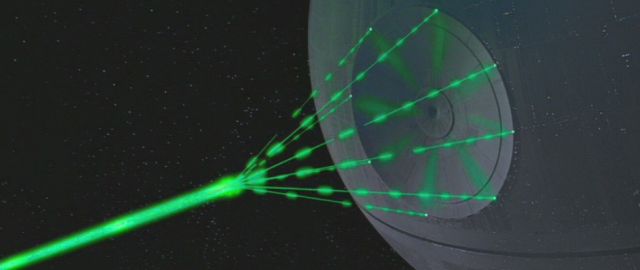
This feature on Mars is a candidate cavern entrance. It is northeast of Arsia Mons – one of the four giant Tharsis volcanoes on the red planet. Credit: NASA/JPL/University of Arizona
Posted on 06/06/2007 12:13:11 PM PDT by NormsRevenge
A very dark spot on Mars could be an entrance to a deep hole or cavern, according to scientists studying imagery taken by NASA's Mars Reconnaissance Orbiter.
The geological oddity measures some 330 feet (100 meters) across and is located on an otherwise bright dusty lava plain to the northeast of Arsia Mons, one of the four giant Tharsis volcanoes on the red planet.
The hole might be the sort of place that could support life or serve as a habitat for future astronauts, researchers speculated.
Must be deep
The Mars Reconnaissance Orbiter (MRO) used its High Resolution Imaging Science Experiment (HiRISE) instrument to draw a bead on the apparent deep hole - a feature that may cause more scientists to ponder about potential subsurface biology on Mars.
Because the spot lacks a raised rim or tossed out material called ejecta, researchers have ruled out the pit being an impact crater. No walls or other details can be seen inside the hole, and so any possible walls might be perfectly vertical and extremely dark or - more likely - overhanging.
HiRISE image specialists said the pit must be very deep to prevent detection of the floor from natural daylight, which is quite bright on Mars.
In April, it was announced that the NASA Mars Odyssey and its Thermal Emission Imaging System (THEMIS) found near the equator seven dark spots that scientists think could be entrances to underground caves.
Meanwhile, MRO is ready to target the dark spots on Mars over the coming months as opportunities arise, explained HiRISE principal investigator, Alfred McEwen, of the University of Arizona in Tucson.
"We especially want oblique images from the west, to see illuminated walls. These are deep holes with overhanging walls, but perhaps not long caves," McEwen told SPACE.com.
Cave dwellers
Caves on Mars gives rise to thinking about subsurface life on the planet, notes Peter Smith, principal investigator for NASA's next outbound mission to that distant and dusty world, the Phoenix lander. The deeper and deeper you go down on Mars, the warmer and warmer it gets, Smith said, and at some point the conditions are just right where liquid water is stable.
Moreover, could caves be linked to underground fractures allowing water vapor to be trapped inside, Smith speculates, perhaps the sort of comfy environment ideal for biology.
Smith said caves on Mars are an exciting find. "We can't say what's in the caves. It's just that they exist. It is hard to tell from orbit. Landers can follow up on these discoveries."
Penny Boston, director of cave and karst studies at New Mexico Tech in Socorro, New Mexico, has been working on a Caves of Mars Project, funded by the NASA Institute for Advanced Concepts.
Not only are natural caves of biological interest, Boston says, they could also serve as habitats for future human explorers - nifty underground housing to protect against the high-radiation environment of Mars. Additionally, caves offer easier subsurface access for direct exploration and drilling, she suggests, and may provide extractable minerals, gases, and ices.

This feature on Mars is a candidate cavern entrance. It is northeast of Arsia Mons – one of the four giant Tharsis volcanoes on the red planet. Credit: NASA/JPL/University of Arizona
There are seven of these. They are not holes but redacted portions of the images. The same regions were imaged by other satellites and should be compared.
Looks like a big faceplant...
and all kinds of other images from Mars.. Courtesy of HiRISE, University of Arizona and Nasa / JPL
http://hirise.lpl.arizona.edu/nea.php
More importantly, did they find Ben Affleck’s career?
Mars has a naval!
Looks like a hole in the ozone!
What ever are the Martians doing?
That's weird, someone said there were smoking holes near Grover's Mill, New Jersey also.
It looks like some company paid to have that painted black. Which company has a black dot for its logo?
The Planetary Society showed seven of these on its news release. They are blacked out regions of the image. A couple of them are clearly craters but all are 0000 black.
It’s a good thing I posted this in chat.
I was wondering what kind of critter might live in that hole? Yikes!
It looks like the photogarpher’s pen leaked on the picture to me.
330 X 330 feet happens to be the standard size of an aliquot 2.5 acre lot. These are roundish so would be a little less than 2.5 acres, but you are looking at standard gov't lot homesites as they would appear on Mars.

I sure hope not.
just so you end up with a lot with a good view..
They have a pile of pics in their catalog at the HiRISE AS/JPL site..
http://hirise.lpl.arizona.edu/katalogos.php

Disclaimer: Opinions posted on Free Republic are those of the individual posters and do not necessarily represent the opinion of Free Republic or its management. All materials posted herein are protected by copyright law and the exemption for fair use of copyrighted works.